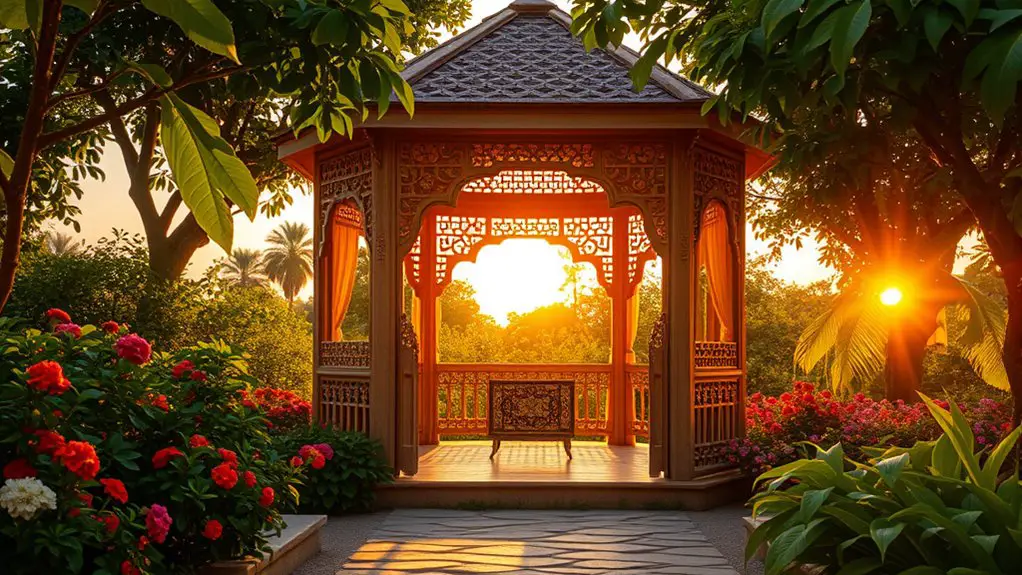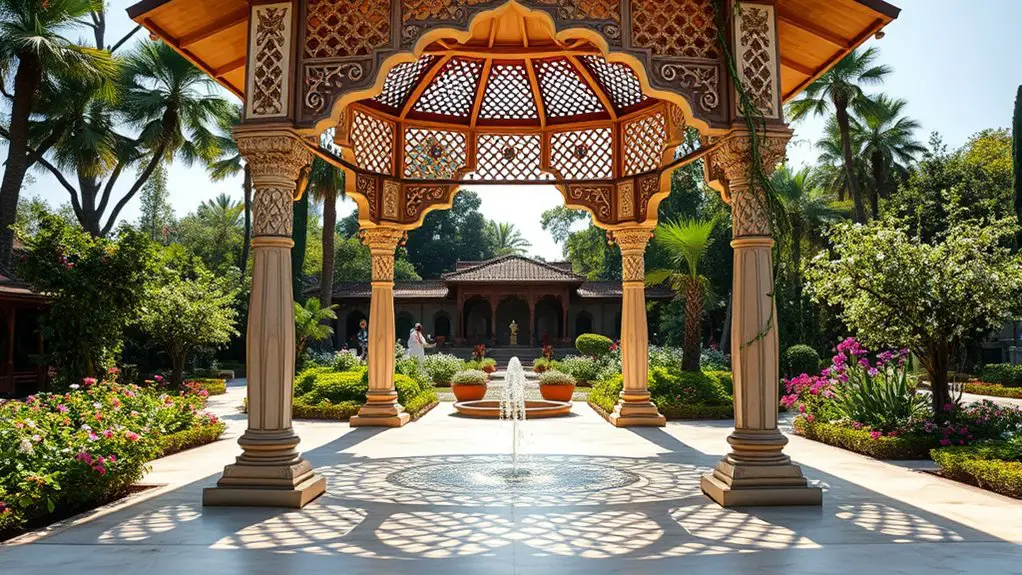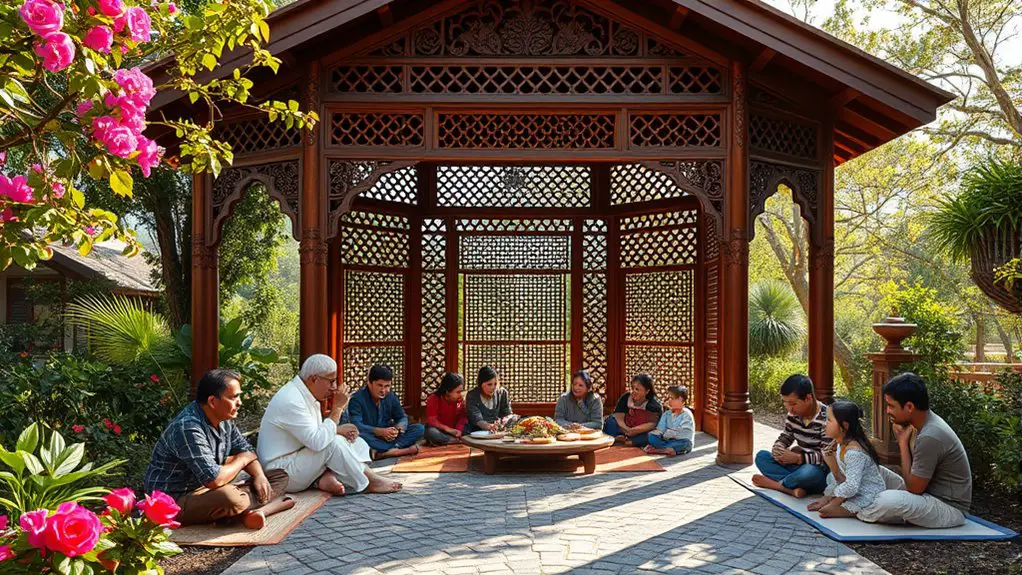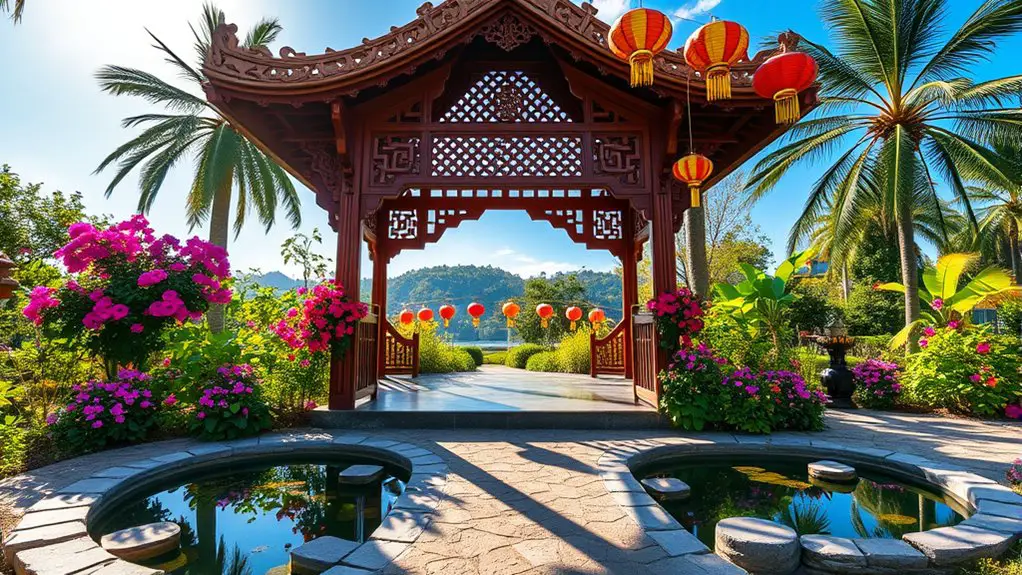In Indian and Asian gardens, gazebo traditions reveal a rich tapestry of cultural exchange and architectural beauty. You’ll see that gazebos, like the intricate chhatris of Mughal gardens and simplistic tea houses in Japan, symbolize harmony and tranquility. These structures foster social interaction and community bonding, reflecting a deep connection with nature. Various design elements and seasonal adaptations further enhance their significance. Discover how these rich traditions continue to evolve and shape modern landscape architecture.
The Historical Origins of Gazebos in Indian and Asian Gardens

Gazebos, often seen as serene retreats in gardens, have rich historical roots in Indian and Asian landscapes. You’ll find that their origins are deeply intertwined with various historical influences, reflecting the cultural exchanges that shaped these regions over centuries. In India, for instance, the Mughal era brought forth exquisite structures that served both aesthetic and functional purposes, often adorned with intricate carvings and set in lush gardens. Similarly, in Asia, the evolution of gazebos mirrors the philosophical ideals of harmony and balance, central to many cultures. These structures were not merely places for relaxation; they represented a fusion of artistry and nature, showcasing the unique identities of their surroundings. By examining these historical influences, you gain insight into how gazebos became symbols of tranquility and cultural significance, fostering a sense of freedom and connection with nature that still resonates today.
Architectural Styles of Gazebos Across Cultures
As you explore the architectural styles of gazebos across cultures, you’ll notice distinct characteristics that reflect regional aesthetics and cultural values. Traditional Indian gazebos, known as chhatris, often feature intricate carvings and domed roofs, symbolizing royal heritage and spiritual significance. In contrast, Asian garden structures, like the Japanese tea house, emphasize simplicity and harmony with nature, showcasing a profound connection to the environment.
Traditional Indian Gazebos
In the domain of architectural beauty, traditional Indian gazebos, known as “chhatris,” stand out for their intricate designs and cultural significance. These structures embody traditional design principles, merging aesthetic appeal with functional grace. Typically situated in gardens and palaces, chhatris serve as shaded resting spots, allowing for contemplative moments amidst nature. Their domed roofs and ornate carvings not only showcase craftsmanship but also convey cultural symbolism, representing royalty and the divine. You’ll find that the use of materials like stone and marble reflects local artistry, creating a dialogue between nature and architecture. By integrating these gazebos into your garden, you can evoke a sense of history and spirituality, bridging the past with the present in a unique, meaningful way.
Asian Garden Structures
While exploring the diverse architectural styles of gazebos across Asian cultures, one quickly discovers the rich tapestry of designs that reflect regional aesthetics and cultural values. In many Asian gardens, you’ll find bamboo structures that embody sustainability and natural beauty, harmonizing with surrounding ornamental plants. Gazebos often feature integrated water features, enhancing tranquility and inviting reflection. Thoughtfully designed garden pathways lead you to these shelters, where seating arrangements encourage relaxation and connection with nature. Lighting designs illuminate these spaces at night, creating an enchanting atmosphere. Cultural influences shape each gazebo’s form, from traditional pagodas to modern interpretations, ensuring a cohesive landscape harmony that invites freedom and contemplation in the midst of nature’s splendor.
The Role of Gazebos in Mughal Gardens

Although often overlooked, gazebos play a pivotal role in the design and experience of Mughal gardens, serving as both architectural focal points and serene retreats. Rooted in Mughal aesthetics, these structures embody the grandeur and harmony that characterize these gardens. You’ll find that gazebos often reflect the intricate geometric designs and symmetrical layouts typical of Mughal architecture, creating a visual harmony that enhances the overall landscape.
Symbolically, they represent a space of contemplation and leisure, inviting visitors to pause and appreciate the beauty surrounding them. Positioned strategically amidst lush greenery and reflective water features, gazebos serve not just as sheltered spots but as contemplative zones, where nature’s tranquility can be fully embraced. This dual role, as both an architectural element and a symbol of peace, underscores the Mughal gardens’ intention to create a paradise on earth, allowing you to experience the sublime interconnectedness of architecture and nature.
Japanese Tea Gardens and Their Gazebo Aesthetics
Gazebos in Japanese tea gardens embody a unique aesthetic that harmonizes with the surrounding landscape, reflecting the principles of simplicity and tranquility inherent in Japanese design philosophy. These structures invite you to immerse yourself in nature, serving as tranquil spaces for contemplation and connection. With their minimalist design, gazebos align with Zen aesthetics, emphasizing the beauty found in understated elegance.
During tea ceremonies, the gazebo becomes a focal point, enhancing cultural rituals that celebrate mindfulness and presence. The careful placement of these structures encourages a seamless interaction between the natural environment and human experience, fostering a sense of balance and peace. Gazebos provide shade, shelter, and outdoor comfort, enhancing the overall experience of the garden.
As you partake in Japanese tea, the gazebo’s presence amplifies the serenity of the garden, creating an atmosphere conducive to reflection and harmony. This unique blend of architectural beauty and natural elements exemplifies the profound relationship between space, culture, and the art of tea.
Cultural Significance of Gazebos in Social Gatherings

As you gather with friends or family, the gazebo often serves as a crucial gathering point, fostering social interaction and community bonding. These structures, steeped in cultural significance, provide a serene backdrop for various social gatherings, from casual picnics to elaborate cultural celebrations.
The architectural design of gazebos enhances their role as communal hubs, inviting a sense of togetherness and shared experience. In many Asian traditions, they symbolize unity and harmony, encouraging people to engage and connect. Whether it’s during a festival, a wedding reception, or a simple afternoon barbecue, the gazebo becomes a space where stories are shared, laughter resonates, and relationships deepen.
Moreover, the presence of a gazebo in gardens reflects a commitment to nurturing community ties, bridging generational gaps and fostering inclusivity. Consequently, these structures transcend mere aesthetics, becoming essential components of social life that reinforce cultural values and collective identity.
Gazebos as Spaces for Meditation and Reflection
Gazebos have historically served as tranquil retreats, allowing individuals to escape the chaos of everyday life and engage in introspection. Their design elements, such as open spaces and natural materials, enhance a sense of serenity, promoting mindfulness and reflection. By understanding these attributes, you can appreciate how gazebos create an ideal environment for meditation.
Historical Significance of Gazebos
While gardens have long served as sanctuaries for contemplation, the inclusion of gazebos has elevated these spaces into profound domains of meditation and reflection. Historically, gazebos reflect cultural influences that have shaped their design evolution across various civilizations. These structures, often strategically positioned within gardens, offer a retreat from the chaos of daily life, inviting individuals to pause, ponder, and connect with nature. Their architectural forms—ranging from the intricate designs of Asian pagodas to the elegant simplicity of Indian chhatris—exemplify how cultural narratives intertwine with the natural world. As you step inside a gazebo, you’re not just entering a physical space; you’re embracing a legacy that transcends time, fostering introspection and a deeper appreciation for the tranquility that surrounds you.
Design Elements for Serenity
The harmonious integration of design elements in gazebos greatly enhances their role as sanctuaries for meditation and reflection. By incorporating natural materials, calming colors, and thoughtful spatial layouts, gazebos become tranquil spaces that invite introspection amidst serene landscapes.
| Element | Description | Effect on Serenity |
|---|---|---|
| Natural Materials | Wood, stone, and bamboo | Connects users to nature |
| Color Palette | Soft greens, blues, and earth tones | Evokes calmness and peace |
| Spatial Layout | Open yet sheltered | Encourages relaxation and focus |
Such design choices not only create an aesthetic appeal but also promote an atmosphere conducive to mindfulness, allowing you to escape the chaos of daily life and find solace in nature.
Traditional Materials and Craftsmanship in Gazebo Construction
Although modern construction techniques have introduced a variety of materials and methods, traditional gazebo construction remains rooted in time-honored craftsmanship and natural resources. You’ll find that artisans often rely on local cultural materials, such as bamboo, teak, or stone, each selected for durability and aesthetic appeal. This approach not only reflects the environment but also honors the cultural identity tied to the region’s history.
The process involves meticulous attention to detail, where skilled craftsmen utilize hand tools and techniques passed down through generations. Such traditional craftsmanship guarantees that each gazebo isn’t merely a structure but a reflection of the artistry and values of its creators. You’ll notice intricate carvings and joinery that speak volumes about the dedication and love poured into each piece. Ultimately, these gazebos serve as serene retreats, inviting you to appreciate the harmonious blend of nature and human skill, a celebration of heritage that transcends time.
Seasonal Adaptations of Gazebos in Indian and Asian Gardens
As seasons change, gazebos in Indian and Asian gardens transform to enhance their functionality and aesthetic appeal, adapting to the diverse climate and cultural practices of the regions. These seasonal modifications reflect a deep understanding of nature’s rhythms and human needs.
- Summer Canopies: During hotter months, gazebos often feature lightweight fabrics or natural materials for shade, allowing for comfortable retreats from the heat while maintaining ventilation.
- Monsoon Preparations: In regions with heavy rains, gazebos may be reinforced with waterproof coverings and drainage systems, ensuring they remain functional spaces for gatherings.
- Winter Insulation: In colder climates, insulating materials or decorative screens can be added to protect against the chill, creating cozy environments for social interactions.
These climate adaptations not only serve practical purposes but also enrich the cultural significance of gazebos, allowing them to remain central to outdoor experiences throughout the year.
Modern Interpretations and Innovations in Gazebo Design
In contemporary garden design, one can observe a fascinating evolution in gazebo architecture that marries tradition with innovation. Today’s gazebos reflect a shift toward minimalist designs, emphasizing simplicity and functionality while maintaining aesthetic appeal. You’ll find structures characterized by clean lines, open spaces, and a harmonious integration with their natural surroundings, allowing for an unobtrusive yet striking presence in gardens.
Moreover, modern interpretations increasingly focus on eco-friendly structures, utilizing sustainable materials and energy-efficient technologies. This commitment to environmental consciousness not only reduces the carbon footprint but also enhances the overall experience of the garden space. When you choose a gazebo today, you’re not just selecting a decorative element; you’re embracing a philosophy that values nature and sustainability. By blending traditional charm with innovative design principles, modern gazebos invite you to enjoy outdoor spaces in ways that resonate with contemporary values and lifestyles. Additionally, permanent gazebos are designed to provide long-lasting shelter and enhance outdoor living experiences, making them a practical choice for modern gardens.
The Future of Gazebos in Landscape Architecture
As you consider the future of gazebos in landscape architecture, it’s crucial to recognize how modern design innovations are reshaping these structures. By integrating sustainable materials, architects are not only enhancing aesthetic appeal but also promoting environmental responsibility. This evolution invites a reexamination of how gazebos can harmonize with both nature and contemporary living.
Modern Design Innovations
While traditional gazebos evoke a sense of nostalgia and romanticism, modern design innovations are reshaping their role in landscape architecture. Today, you’ll find that these structures are evolving to embrace contemporary values. Here are three key innovations:
- Minimalist Aesthetics: Sleek lines and open designs create a tranquil space that blends seamlessly with nature.
- Multifunctional Spaces: Modern gazebos serve as versatile environments, accommodating everything from yoga classes to outdoor dining, enhancing their utility.
- Integrated Technology: Smart features like lighting and sound systems transform gazebos into dynamic areas for entertainment and relaxation.
These advancements reflect a shift towards creating spaces that not only honor tradition but also meet the diverse needs of today’s lifestyle, offering freedom and functionality in outdoor design.
Sustainable Materials Usage
Although the use of sustainable materials in gazebo construction may seem like a recent trend, it reflects a growing awareness of environmental responsibility in landscape architecture. As you explore the future of gazebos, consider how eco-friendly materials like bamboo, reclaimed wood, and recycled metals are transforming design possibilities. These sustainable practices not only minimize ecological footprints but also enhance aesthetic appeal, creating spaces that harmonize with nature. By choosing materials that are responsibly sourced and durable, you contribute to a legacy of environmental stewardship. Furthermore, this approach encourages innovation in design, allowing for unique, customizable structures that resonate with both tradition and modernity. Embracing sustainability guarantees that your gazebos not only beautify landscapes but also protect the environment for generations to come.
Frequently Asked Questions
What Are the Best Plants to Surround a Gazebo?
To surround your gazebo, consider vibrant perennial flowers for color and texture, complemented by climbing vines to create a lush, inviting atmosphere. Together, they enhance the structure’s beauty while providing a sense of tranquility and escape.
How Do I Maintain a Gazebo in My Garden?
Maintaining your gazebo’s charm isn’t intimidating. With seasonal care, you’ll guarantee its longevity. Regularly check for wear, clean surfaces, and apply protective treatments, so it stands proud, inviting you to enjoy your garden’s beauty.
Can Gazebos Be Used for Outdoor Dining?
Yes, gazebos can enhance outdoor dining experiences. You can elevate your gatherings with thoughtful gazebo decor, creating an inviting atmosphere that fosters conversation and connection, all while enjoying nature’s beauty in a serene setting.
What Styles of Furniture Suit Gazebos in Gardens?
You’d think any furniture works in a gazebo, but for true comfort, consider durable materials like wicker or teak. Creative seating arrangements can transform your space, fostering intimate gatherings or serene solitude amidst nature’s embrace.
Are There Any Specific Lighting Ideas for Gazebos?
When considering lighting for your gazebo, fairy lights create a whimsical ambiance, while solar lanterns provide eco-friendly illumination. Both options enhance the space, offering a blend of charm and sustainability that invites relaxation and connection.

